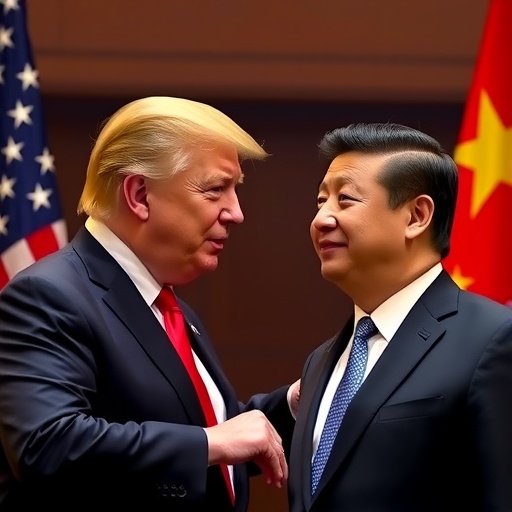US-China trade Talks Ignite in Malaysia: Tariffs, Fentanyl, and Rare Earths Loom Large Before Trump-Xi Summit
In a pivotal move that could reshape global economic dynamics, US Treasury Secretary Scott Bessent and Chinese Vice Premier He Lifeng have kicked off high-level US-China trade negotiations in Kuala Lumpur, Malaysia, setting the stage for Thursday’s highly anticipated Trump-Xi summit. With tariffs hovering at a staggering 157% on key imports, President Donald Trump has signaled that both nations must offer concessions to avert a deepening trade war, while broader issues like the fentanyl crisis, rare-earth mineral exports, and even nuclear weapons discussions hang in the balance.
This development comes amid escalating tensions, as the US grapples with supply chain vulnerabilities and China pushes back against perceived economic coercion. Sources close to the talks reveal that the agenda extends far beyond tariffs, touching on national security and public health crises that have strained bilateral relations for years. As the world watches, these preliminary trade negotiations could determine whether the upcoming Trump-Xi summit fosters détente or escalates into further confrontation.
Bessent and He Lifeng Break Ground in Kuala Lumpur Amid Rising Stakes
The negotiations formally began on Monday morning at a discreet venue in Malaysia’s bustling capital, chosen for its neutral ground status in the often fractious US-China relationship. Treasury Secretary Scott Bessent, a key architect of Trump’s economic strategy, arrived with a delegation of trade experts, emphasizing the urgency of resolving outstanding disputes before the leaders’ face-to-face. On the Chinese side, Vice Premier He Lifeng, known for his pragmatic approach to international commerce, led a team focused on safeguarding Beijing’s interests in technology and resources.
“These talks represent a critical opportunity to align our economic interests and address mutual concerns,” Bessent stated in a pre-negotiation briefing, underscoring the administration’s commitment to fair trade practices. He Lifeng echoed a more cautious tone, noting in a statement from Beijing that “China is open to dialogue but firm on principles of equality and respect.” The choice of Malaysia as the venue is no accident; it harks back to the 2015 Trans-Pacific Partnership discussions hosted there, signaling a nod to multilateralism in an era dominated by bilateral brinkmanship.
Historical context adds weight to these proceedings. The US-China trade war, ignited during Trump’s first term, has already cost American consumers an estimated $195 billion in higher prices since 2018, according to a Peterson Institute for International Economics report. China, meanwhile, has retaliated with tariffs on US agricultural goods, crippling exports of soybeans and pork. As trade negotiations unfold, analysts predict that concessions on intellectual property theft— a perennial US grievance—could emerge as a bargaining chip, potentially unlocking billions in untapped market access for American firms.
The Malaysian setting also highlights Southeast Asia’s growing role as a diplomatic hub. With regional economies like Vietnam and Indonesia benefiting from trade diversions away from China, Kuala Lumpur’s involvement underscores the broader Indo-Pacific ripple effects of US-China frictions.
Tariffs at 157%: Trump’s Push for Concessions Reshapes the Bargaining Table
At the heart of these discussions lies the thorny issue of tariffs, which have ballooned to 157% on certain Chinese goods, including electronics and machinery critical to US manufacturing. Imposed in waves since 2018, these levies were designed to pressure China into reforming its state-subsidized industries, but they’ve instead fueled inflation and disrupted global supply chains. President Trump, in a recent interview with Fox Business, laid out his stance bluntly: “Both sides need to give a little. China can’t keep flooding our markets, and we can’t keep paying the price—literally.”
Economists warn that without de-escalation, the current tariff regime could shave 0.5% off US GDP growth in 2025, per projections from the IMF. For China, the pain is equally acute; exports to the US, which totaled $427 billion last year, face retaliatory measures that have slowed factory output in provinces like Guangdong. During the trade negotiations, Bessent is reportedly advocating for a phased reduction, starting with a 25% cut on non-strategic items, in exchange for Chinese commitments to curb currency manipulation.
Quotes from insiders paint a picture of intense haggling. A US official, speaking anonymously, described the tariff talks as “a chess game where every move risks checkmate.” On the Chinese side, state media has framed the discussions as a chance for “win-win cooperation,” subtly pressuring negotiators to avoid hardline positions that could derail the Trump-Xi summit. Data from the US Census Bureau shows that tariffs have already prompted a 20% shift in imports toward allies like Mexico and Taiwan, illustrating how these duties are redrawing trade maps.
Moreover, the 157% rate isn’t uniform; it’s layered atop Section 301 tariffs and affects over $300 billion in annual trade volume. If concessions are reached, it could stabilize prices for everyday Americans—from smartphone components to auto parts—while giving Chinese exporters a lifeline amid domestic economic slowdowns. Yet, skeptics argue that any deal must include enforcement mechanisms, recalling how the 2020 Phase One agreement faltered due to non-compliance on agricultural purchases.
Fentanyl Flood and Rare Earth Restrictions: Expanding the Trade Agenda
While tariffs dominate headlines, the US-China trade talks are venturing into uncharted territory with discussions on the fentanyl epidemic ravaging American communities and China’s dominance in rare-earth minerals. The US has accused China of being the primary source of precursor chemicals fueling the crisis, which claimed over 100,000 lives in 2023 alone, according to CDC statistics. Bessent raised this issue prominently, linking it to broader trade imbalances: “We can’t separate public health from economic security.”
China, which produces 80% of the world’s rare-earth elements essential for everything from electric vehicles to military hardware, has imposed export restrictions in retaliation for US chip bans. Negotiators are exploring a quid pro quo: eased Chinese controls on these minerals in return for US cooperation on fentanyl interdiction. Vice Premier He Lifeng reportedly proposed joint task forces to monitor chemical shipments, a concession that could save thousands of lives if implemented.
Adding intrigue, whispers of nuclear weapons talks have surfaced, tied to arms control amid rising Indo-Pacific tensions. Though not officially confirmed, a senior US diplomat hinted that “non-proliferation assurances” could sweeten trade deals, referencing China’s expanding arsenal estimated at 500 warheads by the Pentagon. This multifaceted agenda reflects Trump’s holistic approach, blending economics with security.
Statistics underscore the stakes: Fentanyl seizures at the US border hit 27,000 pounds in 2023, mostly traced to Chinese synthetics routed through Mexico. Meanwhile, rare-earth shortages have delayed US defense projects, costing $1.5 billion in overruns. If these threads weave into a comprehensive pact, it could mark a turning point, fostering trust beyond mere commerce.
Trump-Xi Summit Looms: What Success in Malaysia Could Mean for Global Markets
As trade negotiations progress, all eyes turn to Thursday’s Trump-Xi summit in Singapore, where the leaders will build on any breakthroughs from Kuala Lumpur. Trump, fresh off domestic victories, views this as a legacy-defining moment, potentially announcing a “grand bargain” that recalibrates US-China ties. Xi Jinping, facing internal economic pressures, may seek stability to bolster his position ahead of China’s 2027 centennial goals.
Market reactions have been volatile; the Dow Jones surged 1.2% on news of the talks, while Shanghai’s composite index dipped 0.8%, reflecting investor jitters. Experts like those at Goldman Sachs forecast that a tariff rollback could add $500 billion to global trade flows by 2026, boosting sectors from tech to agriculture. However, failure risks a “decoupling” scenario, where US firms relocate en masse, echoing the $1 trillion in investments shifted since 2019.
Forward-looking implications are profound. A successful outcome might pave the way for WTO reforms, addressing subsidies that distort $2 trillion in annual trade. It could also mitigate geopolitical flashpoints, from Taiwan to the South China Sea, by tying economic incentives to restraint. For American workers, relief from tariff-induced inflation—estimated at 2-3% of household costs—would provide tangible wins. Yet, challenges persist: Domestic hawks in both nations could torpedo deals, and enforcement remains a wildcard.
In the coming days, as Bessent and He Lifeng wrap up in Malaysia, the world holds its breath. The path from tariffs to truce is fraught, but the potential for renewed partnership offers a glimmer of hope in an era of division. Whether this leads to enduring stability or fleeting headlines will define not just US-China relations, but the trajectory of the global economy for years to come.









